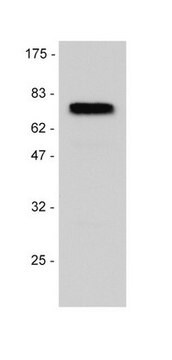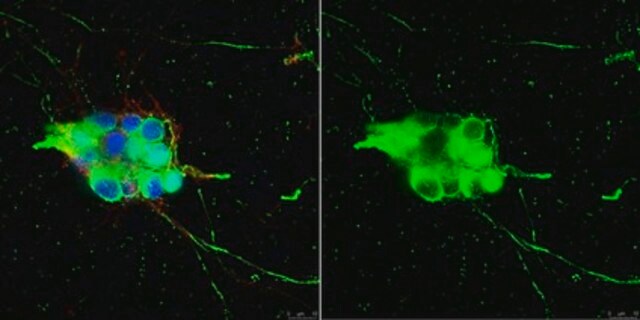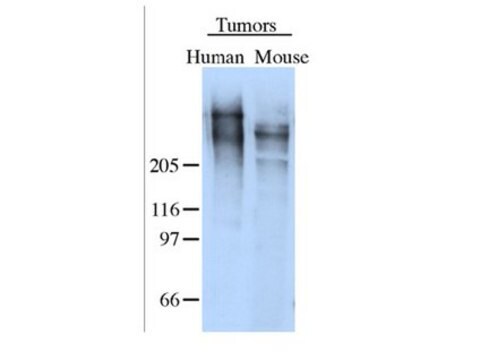ABN1655
Anti-p75NTR Antibody, ICD
serum, from rabbit
Synonym(s):
Tumor necrosis factor receptor superfamily member 16, CD271, Gp80-LNGFR, Low-affinity nerve growth factor receptor, Low affinity neurotrophin receptor p75NTR, NGF receptor, p75 ICD
About This Item
Recommended Products
biological source
rabbit
Quality Level
antibody form
serum
antibody product type
primary antibodies
clone
polyclonal
species reactivity
chicken, mouse, human, rat
technique(s)
immunocytochemistry: suitable
immunofluorescence: suitable
immunoprecipitation (IP): suitable
western blot: suitable
NCBI accession no.
UniProt accession no.
shipped in
ambient
target post-translational modification
unmodified
Gene Information
rat ... Ngfr(24596)
General description
Specificity
Immunogen
Application
Immunofluorescence Analysis: A representative lot localized p75ICD immunoreactivity in cryosections from various stages of chick embryos fixed with 4% paraformaldehyde and permeabilized by 0.1% Triton X-100 (López-Sánchez, N., et al. (2007). Physiol. Genomics. 30(2):156-171).
Immunoprecipitation Analysis: A representative lot co-immunoprecipitated NRIF with p75 from rat sympathetic neurons. Co-immunoprecipitation of exogenously expressed NRIF and p75 by this antiserum was also seen using 293 transfectant. Increased CTF and ICD fragments were immunoprecipitated from PMA-treated 293 transfectants and from BDNF-treated neurons (in the presence of proteasome inhibitor). Co-treatment with gamma-secretase inhibitor abolished ICD, but not CTF cleavage in PMA- and BDNF-treated cells (Kenchappa, R.S., et al. (2006). Neuron. 50(2):219-232).
Western Blotting Analysis: A representative lot detected p75 in rat sympathetic neurons. Increased ~30 kDa CTF and ~25 kDa ICD fragments were detected from BDNF- or PMA-, but not NGF-, treated neurons (in the presence of proteasome inhibitor). Co-treatment with gamma-secretase inhibitor abolished ICD, but not CTF cleavage in BDNF-treated cells (Kenchappa, R.S., et al. (2006). Neuron. 50(2):219-232).
Western Blotting Analysis: A representative lot detected p75 in superior cervical ganglia (SCG) whole tissue lysate from P4 and P24 postnatal rats. CTF and ICD fragments were detected only in P4, but not P24 SCG lysate (Kenchappa, R.S., et al. (2006). Neuron. 50(2):219-232).
Neuroscience
Quality
Western Blotting Analysis: A 1:5,000 dilution of this antiserum detected the ~25 kDa p75NTR (neurotrophin receptor) ICD fragment in 10 µg of mouse retina tissue lysate.
Target description
Physical form
Storage and Stability
Handling Recommendations: Upon receipt and prior to removing the cap, centrifuge the vial and gently mix the solution. Aliquot into microcentrifuge tubes and store at -20°C. Avoid repeated freeze/thaw cycles, which may damage IgG and affect product performance.
Other Notes
Disclaimer
Not finding the right product?
Try our Product Selector Tool.
Storage Class
12 - Non Combustible Liquids
wgk_germany
WGK 1
Certificates of Analysis (COA)
Search for Certificates of Analysis (COA) by entering the products Lot/Batch Number. Lot and Batch Numbers can be found on a product’s label following the words ‘Lot’ or ‘Batch’.
Already Own This Product?
Find documentation for the products that you have recently purchased in the Document Library.
Our team of scientists has experience in all areas of research including Life Science, Material Science, Chemical Synthesis, Chromatography, Analytical and many others.
Contact Technical Service








